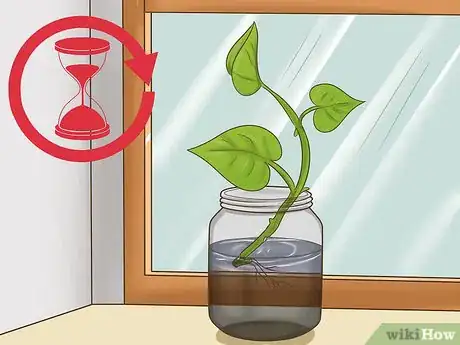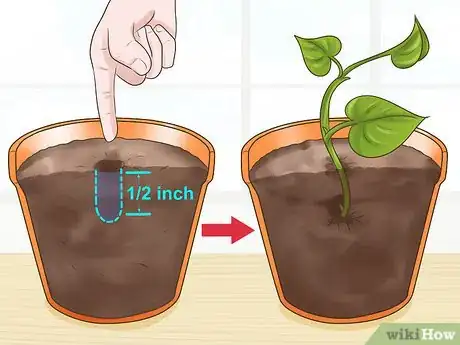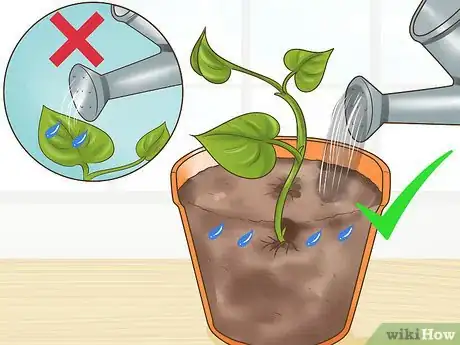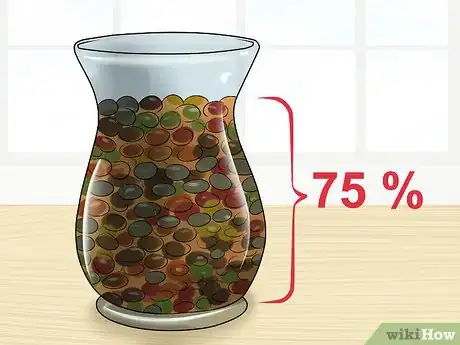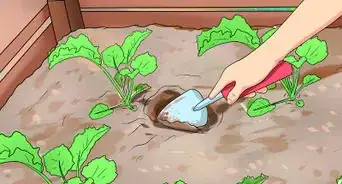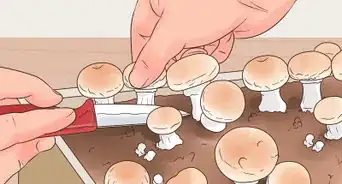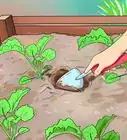This article was co-authored by Lindsey Swett. Lindsey Swett is a Plant Specialist and the Owner of Niche Plant Shop in Boston, Massachusetts. She has over a decade of experience working in several plant settings, including golf courses, public parks, and commercial garden centers. Her focus now is on helping plant owners care for their indoor plants. Lindsey holds a Master of Landscape Architecture from The University of Michigan.
This article has been viewed 102,915 times.
Cloning, otherwise known as propagating, pothos is a very easy way to multiply and give away some of your beautiful, popular plant, without buying any more. Pothos, commonly called "household ivy", is the Epipremnum aureum, a fast growing vining plant that can be found in many homes. Sometimes mistakenly labeled as a Philodendron at stores, this is a great beginner plant that requires very little maintenance.[1]
Steps
Helping it to Grow Roots
-
1Check your chosen vine that you want to cut and see if it is healthy. Do not choose a vine with:
- Yellowing or decaying of the vine portion
- More than a few brown, dried leaves
- Black leaves
- Decaying/dead growth-tip of the vine
-
2Cut off a piece of vine that's at least 6 inches (15.2 cm) long, has at least 5 healthy leaves, and has nodes. Nodes are brown stubs opposite each leaf stem on the vine. Cut close to a node, because this is where the roots will sprout.[2]Advertisement
-
3Remove two of the closest leaves to the bottom node. This will prevent the leaves from rotting when placed in water.
-
4Place your cut vine in a jar or container of clean water, only filling the water up to where it covers the bottom one or two nodes. If you want to, you can add a tiny bit of liquid plant fertilizer. Overdoing fertilizer can be bad for your cutting, so if you don't know exactly how much to put, don't risk it.
-
5Put in a place where there is indirect sunlight, and wait. Make sure to check and refill the water level so the node(s) will keep growing roots. Once roots (at least half an inch long) show, you can transplant the cutting quickly if you want your new plant to begin growing in soil.[3] If growing it in water, you can wait to transplant put watch out for stagnating/souring water (pour water out and refill).
Moving it to Soil
-
1Use potting material that is mostly peat and drains well.[4] Whether your plant is growing outside or indoors in a pot, make sure there is at least six inches of soil-depth in which to grow.
- If using a pot, there needs to be a drainage hole and a water tray underneath.
- Using fertilizer is unnecessary, as pothos grows fast and it is optional.
-
2With your finger, make a hole that will cover the cutting up to half an inch above its roots. Place the cutting in the hole and place dirt gently over it to fill the hole. Do not pack down the soil.
-
3Water the plant by sprinkling onto the dirt. Watering on top of the leaves won't ensure all the water gets down to the dirt. The potting soil should be moderately moist and an inch of topsoil; not ever overly wet. Puddles and mud are not good for the plant.
-
4Let the plant grow! With good conditions, with a warm winter climate or re-starting each spring, pothos outside can create a "carpet" of leaves. You can use a trellis to encourage the vines to climb; just twine some long vines through/around the structure. Indoors, it can create a curtain of foliage if several vines are placed on a high shelf.
-
5Water moderately when the soil begins getting dry. Don't soak the soil; just water enough to keep it moist.
Moving it to Water
-
1Get a nice ceramic jar, flower vase, or container that is not taller than the cutting. Even a mason jar will work. The container should allow light to reach all of the leaves. .
-
2Using pebbles or marbles, fill the container about 75% of the way up. Using gravel sold for aquariums is another great substrate. If using material collected from outdoors, soak, brush and rinse it thoroughly first to get rid of any dirt.
- Other alternatives include perlite or Leca as a substrate for propagation.
-
3Make a "hole" through the substrate and place the cutting in it. Gently cover the hole with the rest of the substrate. Choose a fairly long vine to be visually attractive. The roots should be completely covered, and an area up to an inch above the roots can also be covered with substrate (remove leaves that would decay in the water).
-
4Fill the container with water and add liquid fertilizer. Only add enough so that the roots are covered. Some water visible above the substrate level is fine, but avoid putting a lot of the cutting underwater.
- Liquid fertilizer can be as simple as Miracle-Gro. Always make sure that the fertilizer is for plants in water and that you are dosing correctly.
-
5Let it grow! The vines can make a nice, small centerpiece in a casual room. Check on the water level once a week and refill accordingly.
Community Q&A
-
QuestionI noticed that some of the new growth of my pothos plant has dark brown edges. Is this a sign of sun burn?
 CaeiiaTop AnswererUsually it's a sign of not adequate watering. Are you soaking it in just water to grow roots, or is it in soil? If it's in water, try changing the water. Don't keep it in the water too long after it grows roots either; there might not be enough nutrients. If it's in soil, water when the soil is dry (stick a toothpick in the soil to test - wet soil sticks to the toothpick) and don't water excessively. Lastly, too much sun can contribute to your problem by drying out the soil quickly, plus pothos prefer indirect sun.
CaeiiaTop AnswererUsually it's a sign of not adequate watering. Are you soaking it in just water to grow roots, or is it in soil? If it's in water, try changing the water. Don't keep it in the water too long after it grows roots either; there might not be enough nutrients. If it's in soil, water when the soil is dry (stick a toothpick in the soil to test - wet soil sticks to the toothpick) and don't water excessively. Lastly, too much sun can contribute to your problem by drying out the soil quickly, plus pothos prefer indirect sun. -
QuestionMy pothos are not growing; feels like it stopped. What should I do?
 CaeiiaTop AnswererThis usually means it does not have enough space and/or nutrients. If it is in water, try adding liquid fertilizer specific to plants in water (make sure to dose correctly; too much can harm your plant). If the roots are taking up the whole container, you should also move the plant to a larger container. If your plant is in soil, do the same thing (check if the roots have any more room to grow and add fertilizer appropriate to houseplants and soil). Since pothos grows quickly, the culprit is usually not enough space.
CaeiiaTop AnswererThis usually means it does not have enough space and/or nutrients. If it is in water, try adding liquid fertilizer specific to plants in water (make sure to dose correctly; too much can harm your plant). If the roots are taking up the whole container, you should also move the plant to a larger container. If your plant is in soil, do the same thing (check if the roots have any more room to grow and add fertilizer appropriate to houseplants and soil). Since pothos grows quickly, the culprit is usually not enough space. -
QuestionCan I take multiple cuttings from the same vine?
 Community AnswerYes! Pothos tolerate trimming very well. They are one of the hardiest indoor plants.
Community AnswerYes! Pothos tolerate trimming very well. They are one of the hardiest indoor plants.
Warnings
- Do not place pothos leaves or the whole plant underwater. While their roots can get used to water, the vines are not fully aquatic and will rot.⧼thumbs_response⧽
- Once the plant has been established in either soil or water for a long time, a whole pothos will not do well when moved to the opposite environment.⧼thumbs_response⧽
- Pothos should not be placed in an area that gets hours of direct sunlight. A window that does not receive direct sunlight frequently should be okay.⧼thumbs_response⧽
- Pothos is toxic to cats and dogs - causing oral irritation, vomiting, and difficulty in swallowing[5] .⧼thumbs_response⧽
References
- ↑ https://en.wikipedia.org/wiki/Epipremnum_aureum
- ↑ http://www.balconycontainergardening.com/plants/124-propagate-pothos
- ↑ https://www.gardeningknowhow.com/houseplants/pothos/propagating-pothos.htm
- ↑ http://homeguides.sfgate.com/type-container-should-use-pothos-plant-82157.html
- ↑ https://www.aspca.org/pet-care/animal-poison-control/toxic-and-non-toxic-plants/devils-ivy
About This Article
To clone your pothos, start by picking a vine that has at least 5 healthy leaves and nodes, which are the small brown nubs across from each leaf stem. Cut off a piece close to one of the nodes since this is where the root will sprout, and make sure the vine is at least 6 inches long. Remove 2 of the closest leaves to the bottom node to prevent them from rotting when placed in water. Then, put your cut vine in a jar of clean water, filling it enough to cover the bottom nodes. Place the jar in indirect sunlight, and wait, refilling the water whenever it goes too low. Once roots that are at least a half-inch long grow, transplant the cutting to potting material that’s mostly peat. Burry the roots in the soil and water the plant. To learn how to continue growing your cutting in water, keep reading!




